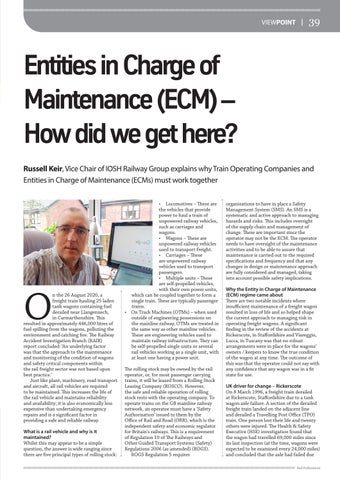VIEWPOINT FEATURE | |
39
Entities in Charge of Maintenance (ECM) – How did we get here? Russell Keir, Vice Chair of IOSH Railway Group explains why Train Operating Companies and Entities in Charge of Maintenance (ECMs) must work together
O
n the 26 August 2020, a freight train hauling 25 laden tank wagons containing fuel derailed near Llangennech, in Carmarthenshire. This resulted in approximately 446,000 litres of fuel spilling from the wagons, polluting the environment and catching fire. The Railway Accident Investigation Branch (RAIB) report concluded: ‘An underlying factor was that the approach to the maintenance and monitoring of the condition of wagons and safety critical components within the rail freight sector was not based upon best practice.’ Just like plant, machinery, road transport and aircraft, all rail vehicles are required to be maintained. This increases the life of the rail vehicle and maintains reliability and availability; it is also economically less expensive than undertaking emergency repairs and is a significant factor in providing a safe and reliable railway. What is a rail vehicle and why is it maintained? Whilst this may appear to be a simple question, the answer is wide ranging since there are five principal types of rolling stock:
• Locomotives – These are the vehicles that provide power to haul a train of unpowered railway vehicles, such as carriages and wagons. • Wagons – These are unpowered railway vehicles used to transport freight. • Carriages – These are unpowered railway vehicles used to transport passengers. • Multiple units – These are self-propelled vehicles, with their own power units, which can be coupled together to form a single train. These are typically passenger trains. • On Track Machines (OTMs) – when used outside of engineering possessions on the mainline railway, OTMs are treated in the same way as other mainline vehicles. These are engineering vehicles used to maintain railway infrastructure. They can be self-propelled single units or several rail vehicles working as a single unit, with at least one having a power unit. The rolling stock may be owned by the rail operator, or, for most passenger carrying trains, it will be leased from a Rolling Stock Leasing Company (ROSCO). However, the safe and reliable operation of rolling stock rests with the operating company. To operate trains on the GB mainline railway network, an operator must have a ‘Safety Authorisation’ issued to them by the Office of Rail and Road (ORR), which is the independent safety and economic regulator for Britain's railways. This is a requirement of Regulation 10 of The Railways and Other Guided Transport Systems (Safety) Regulations 2006 (as amended) (ROGS). ROGS Regulation 5 requires
organisations to have in place a Safety Management System (SMS). An SMS is a systematic and active approach to managing hazards and risks. This includes oversight of the supply chain and management of change. These are important since the operator may not be the ECM. The operator needs to have oversight of the maintenance activities and to be able to assure that maintenance is carried out to the required specifications and frequency and that any changes in design or maintenance approach are fully considered and managed, taking into account possible safety implications. Why the Entity in Charge of Maintenance (ECM) regime came about There are two notable incidents where insufficient maintenance of a freight wagon resulted in loss of life and so helped shape the current approach to managing risk in operating freight wagons. A significant finding in the review of the accidents at Rickerscote, in Staffordshire and Viareggio, Lucca, in Tuscany was that no robust arrangements were in place for the wagons’ owners / keepers to know the true condition of the wagon at any time. The outcome of this was that the operator could not say with any confidence that any wagon was in a fit state for use. UK driver for change – Rickerscote On 8 March 1996, a freight train derailed at Rickerscote, Staffordshire due to a tank wagon axle failure. A section of the derailed freight train landed on the adjacent line and derailed a Travelling Post Office (TPO) train. One person lost their life and twenty others were injured. The Health & Safety Executive (HSE) investigation found that the wagon had travelled 69,000 miles since its last inspection (at the time, wagons were expected to be examined every 24,000 miles) and concluded that the axle had failed due Rail Professional
